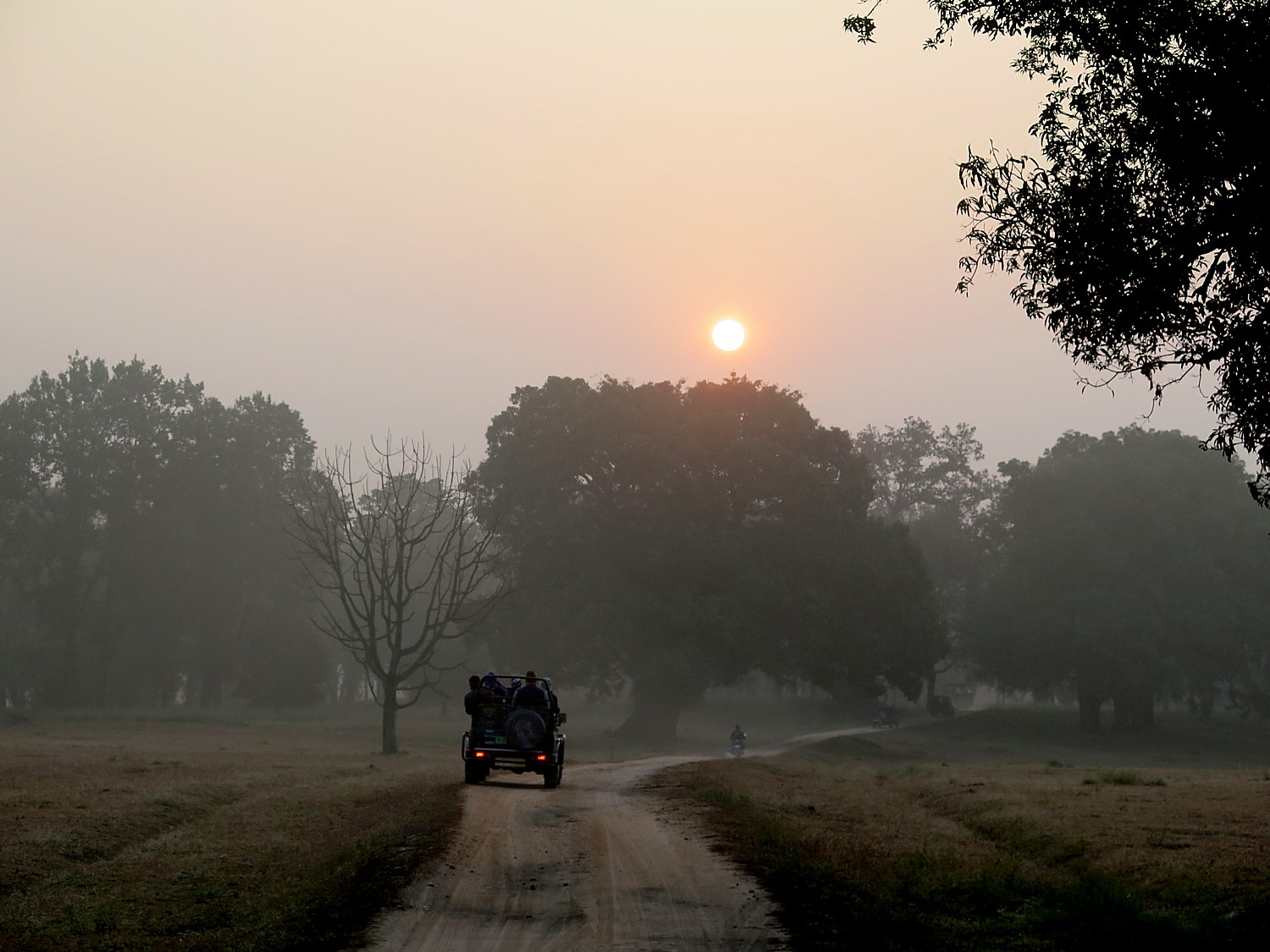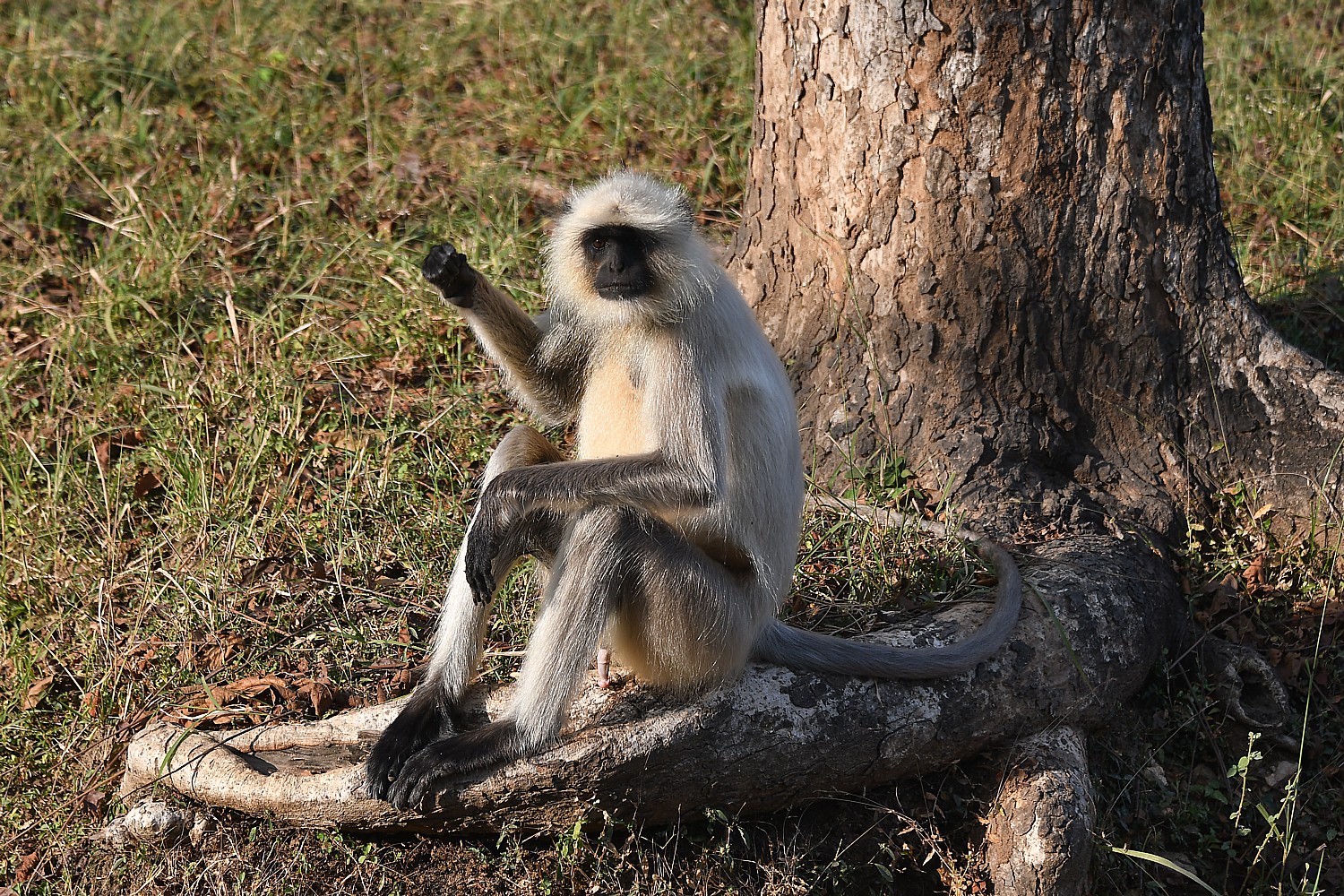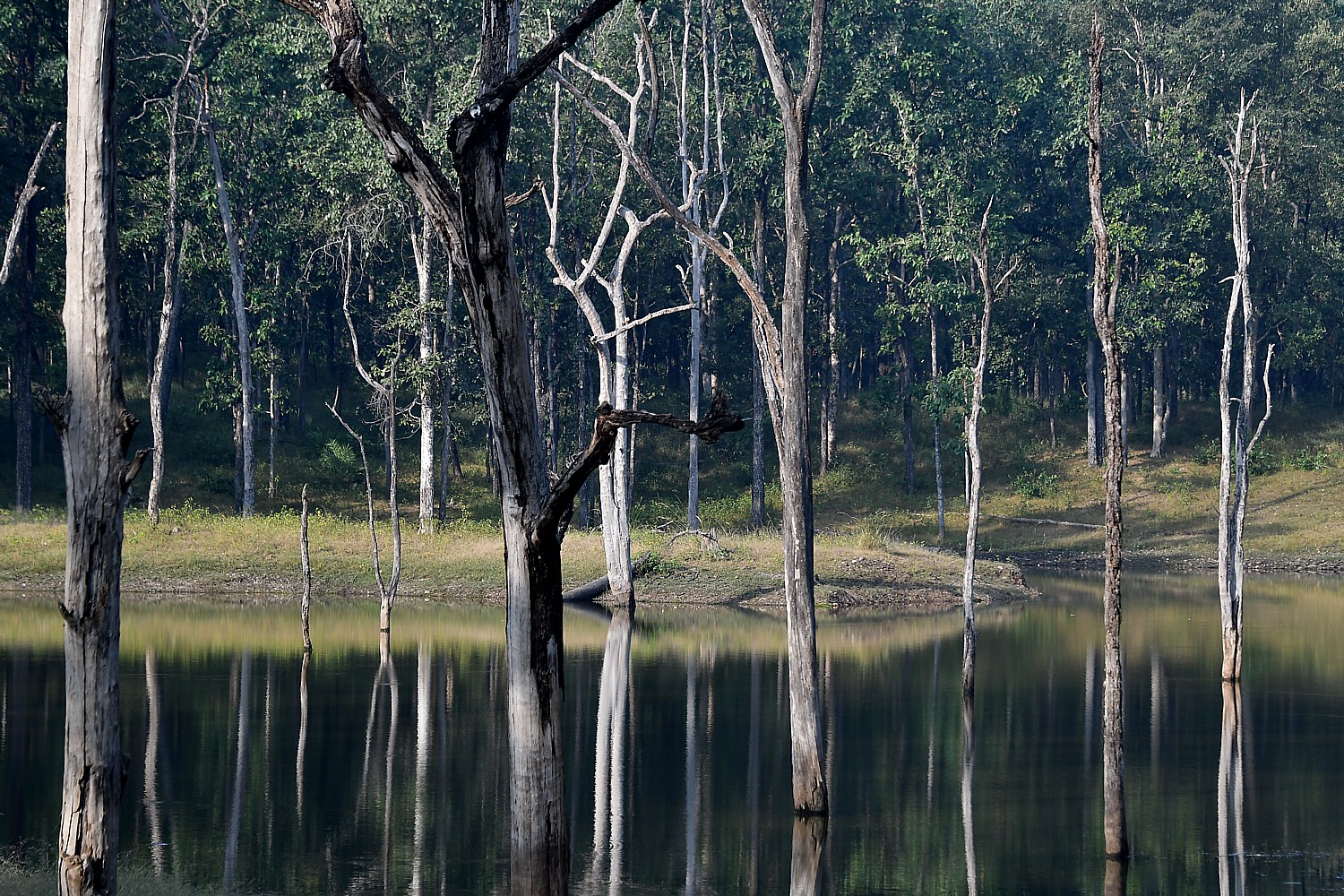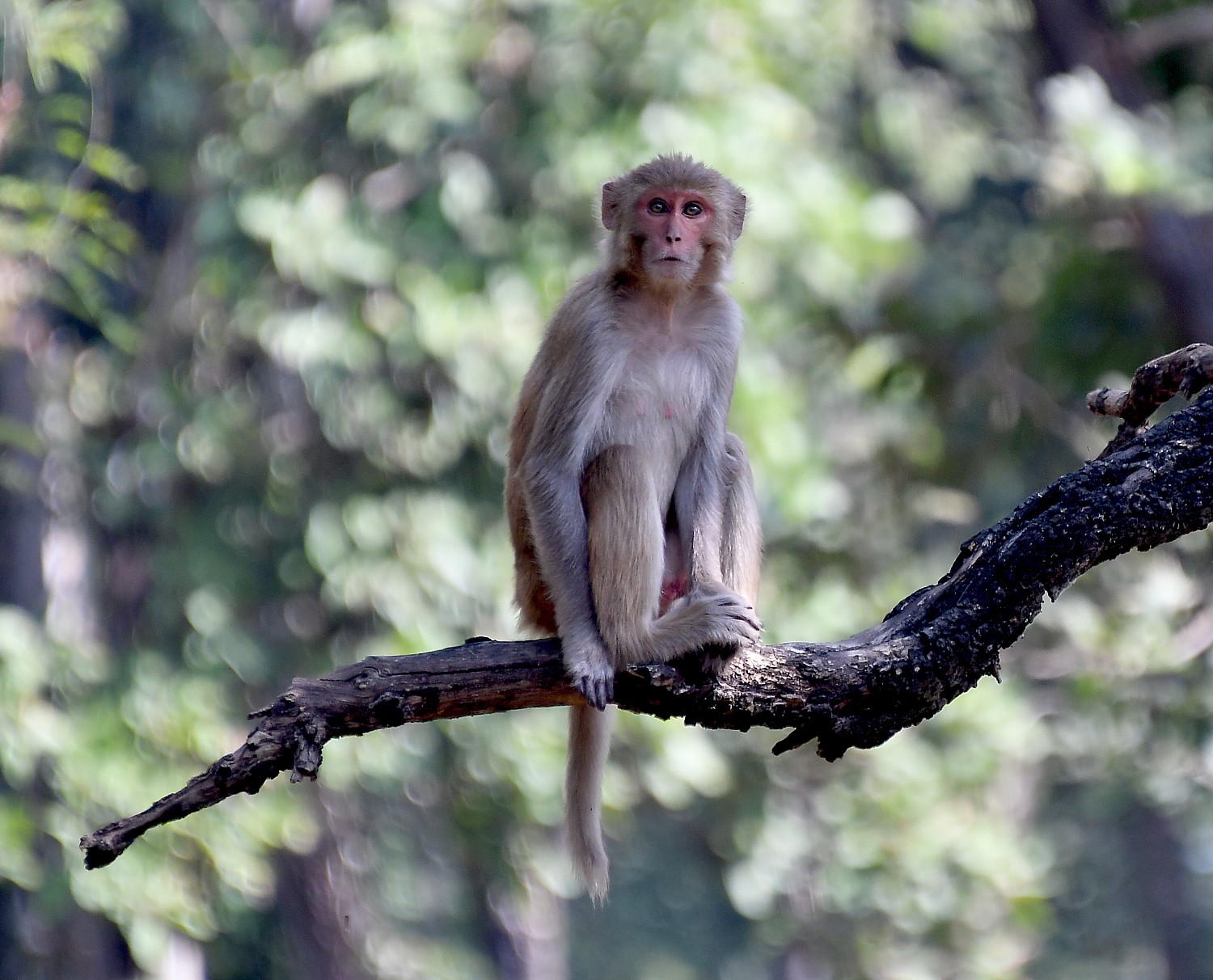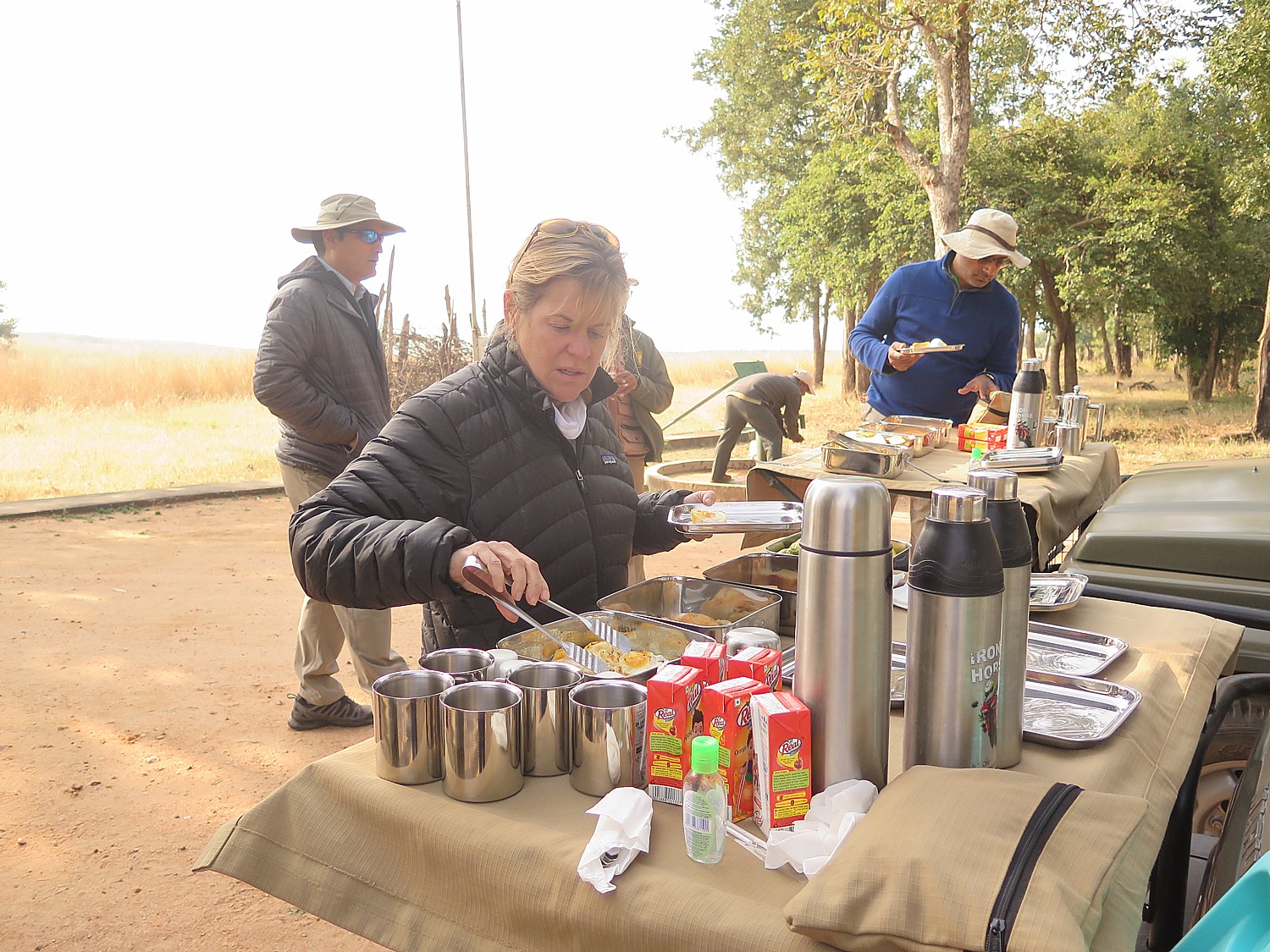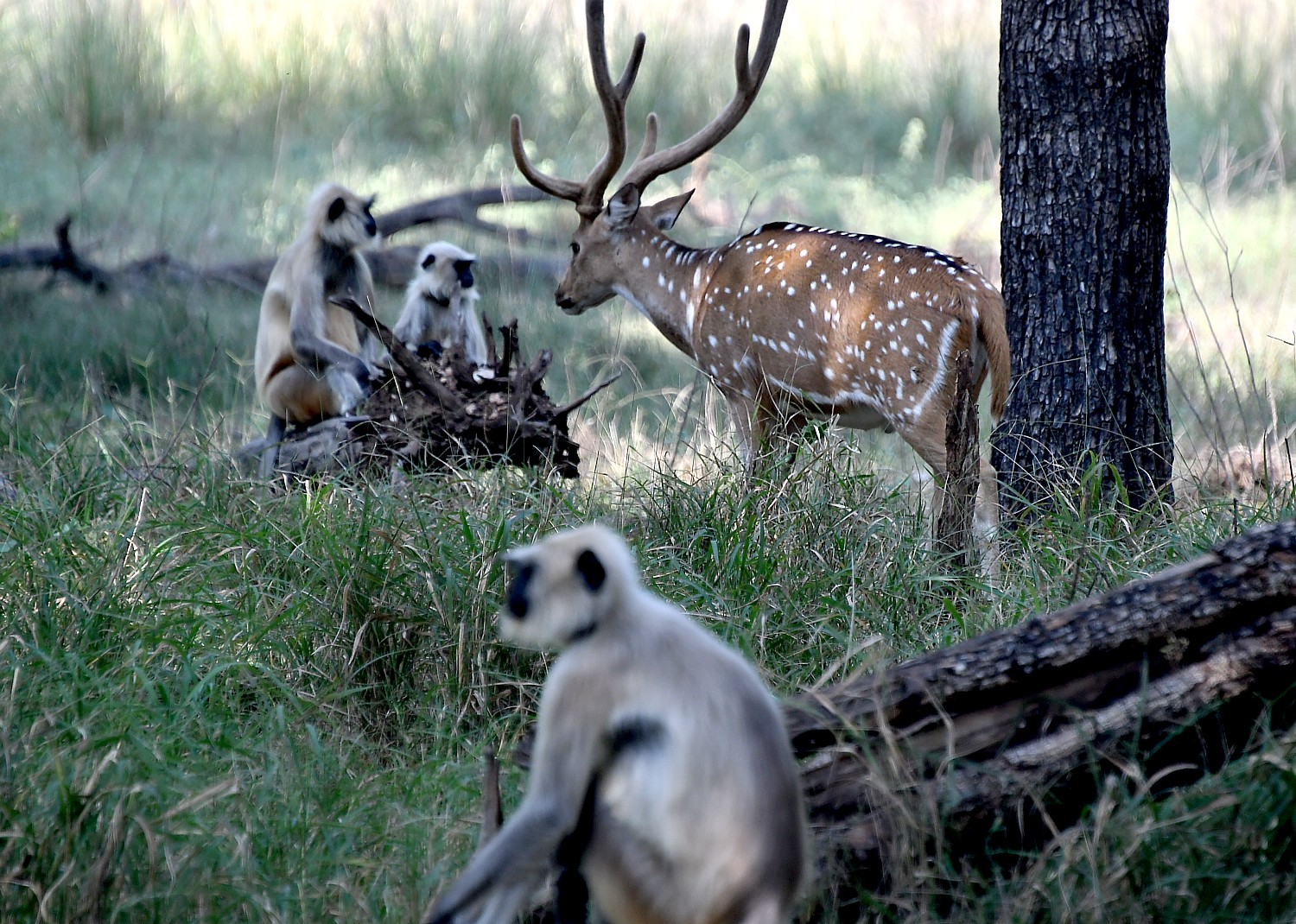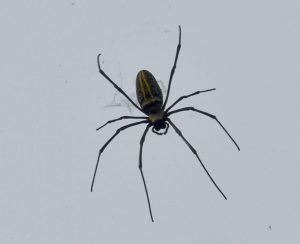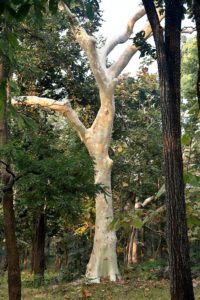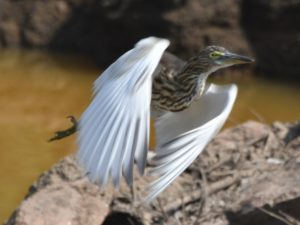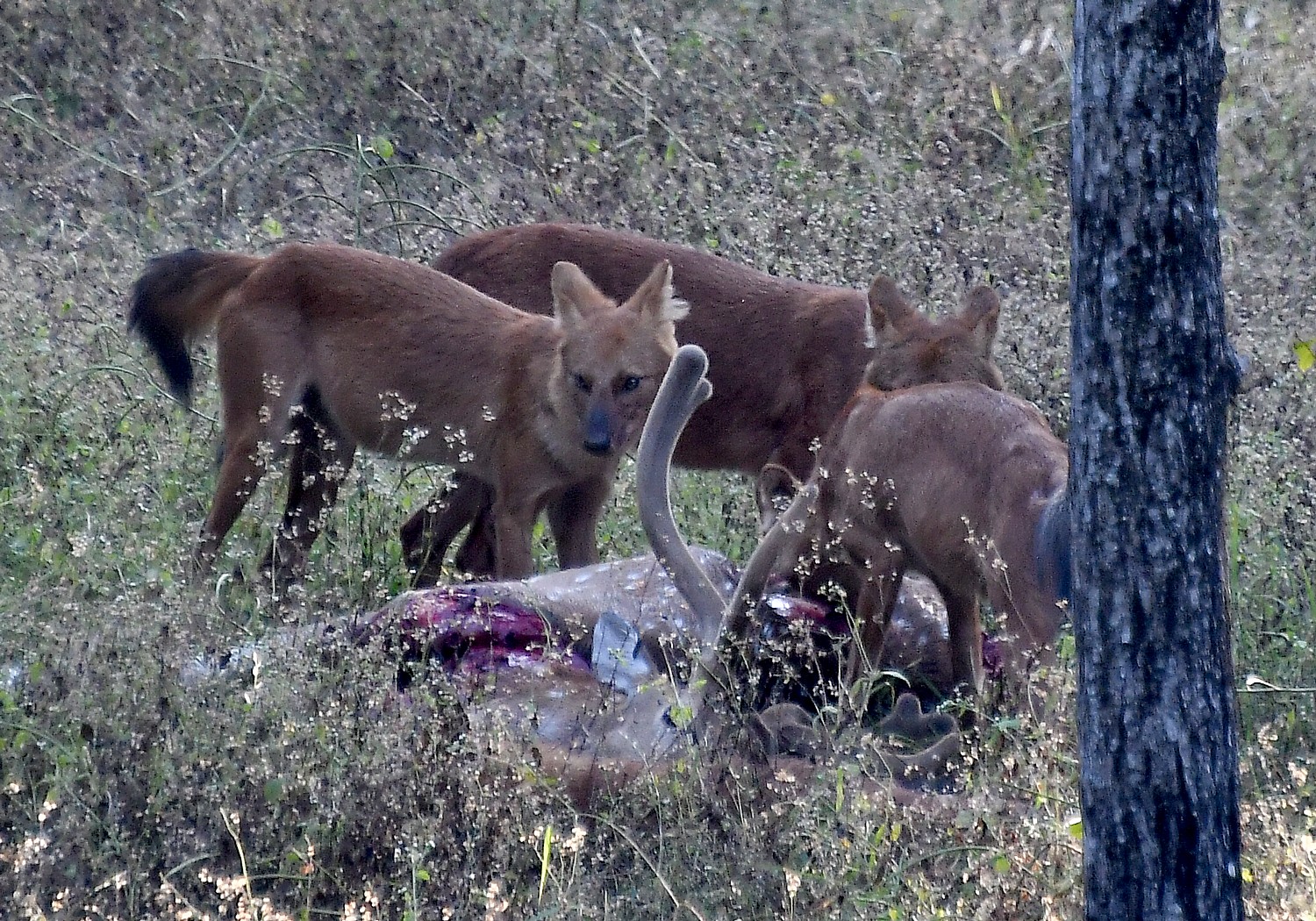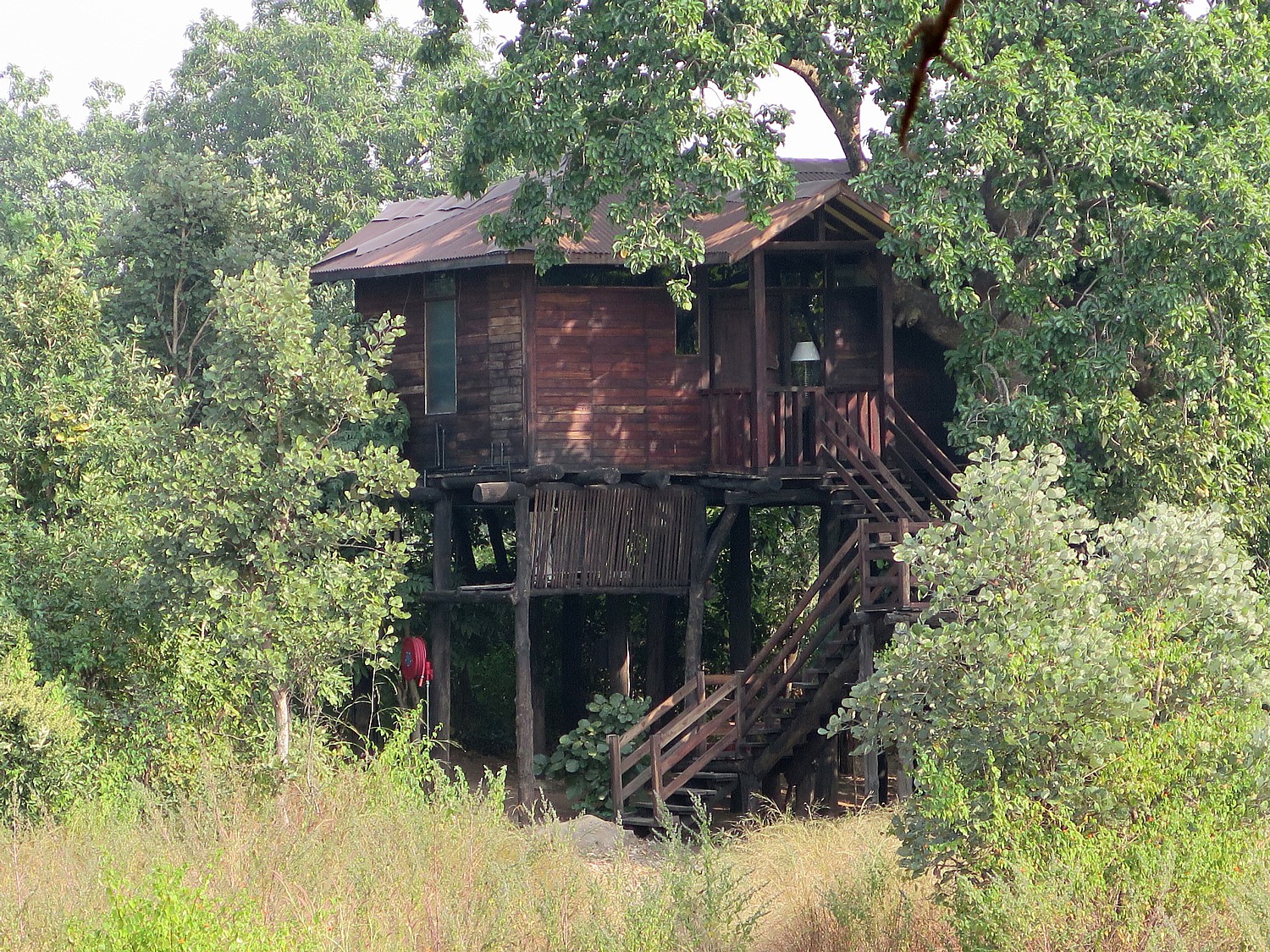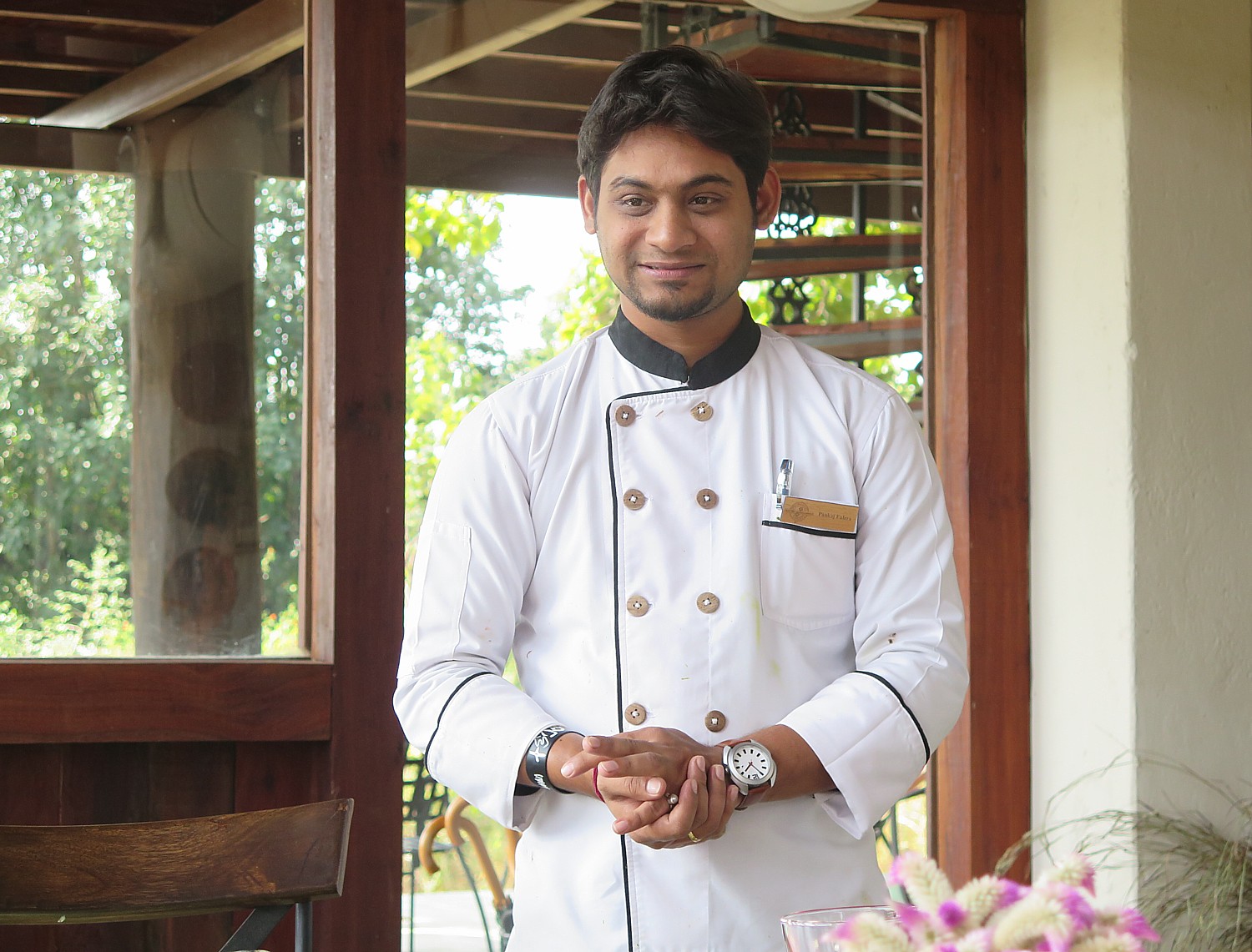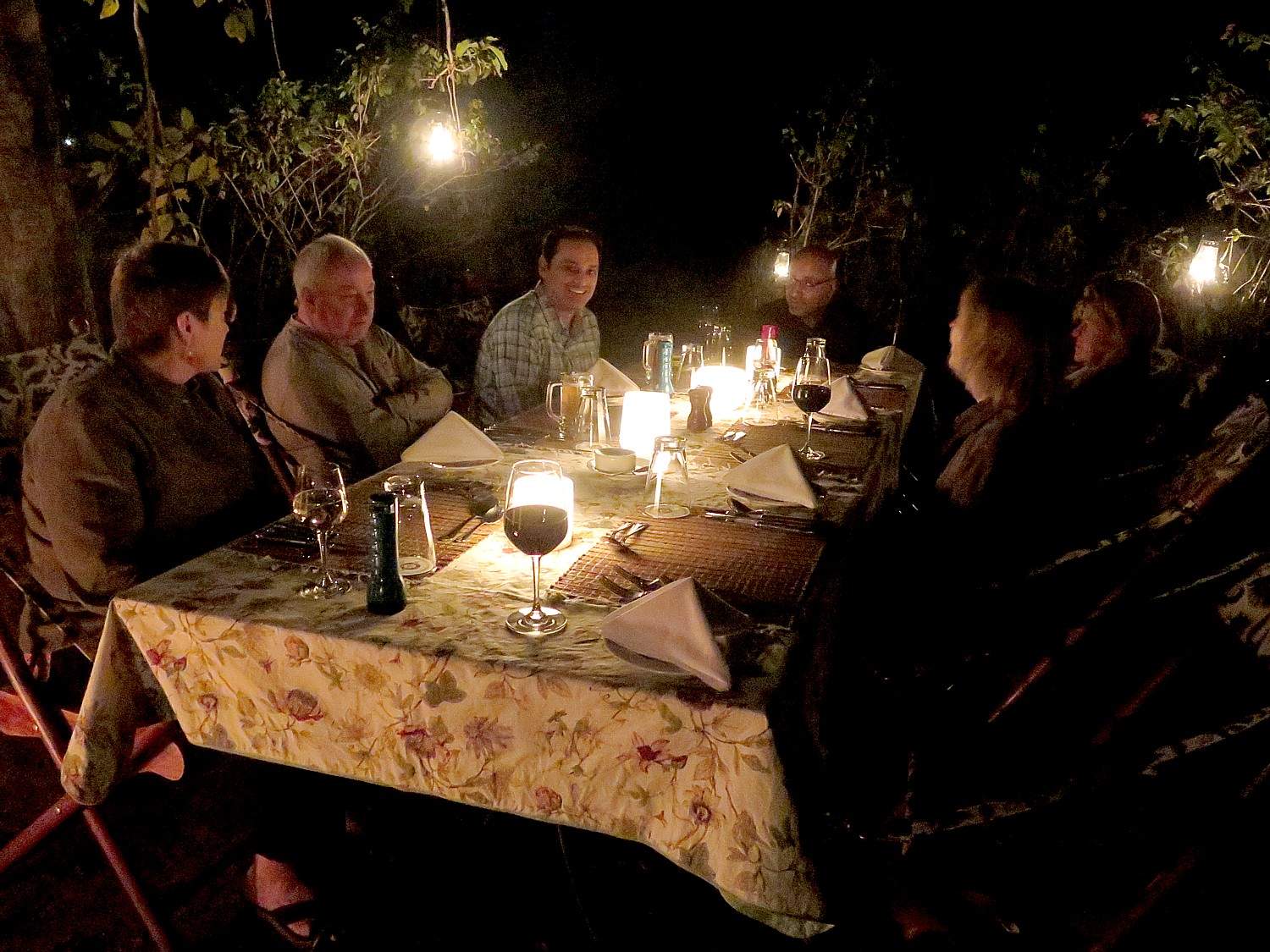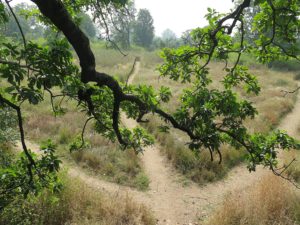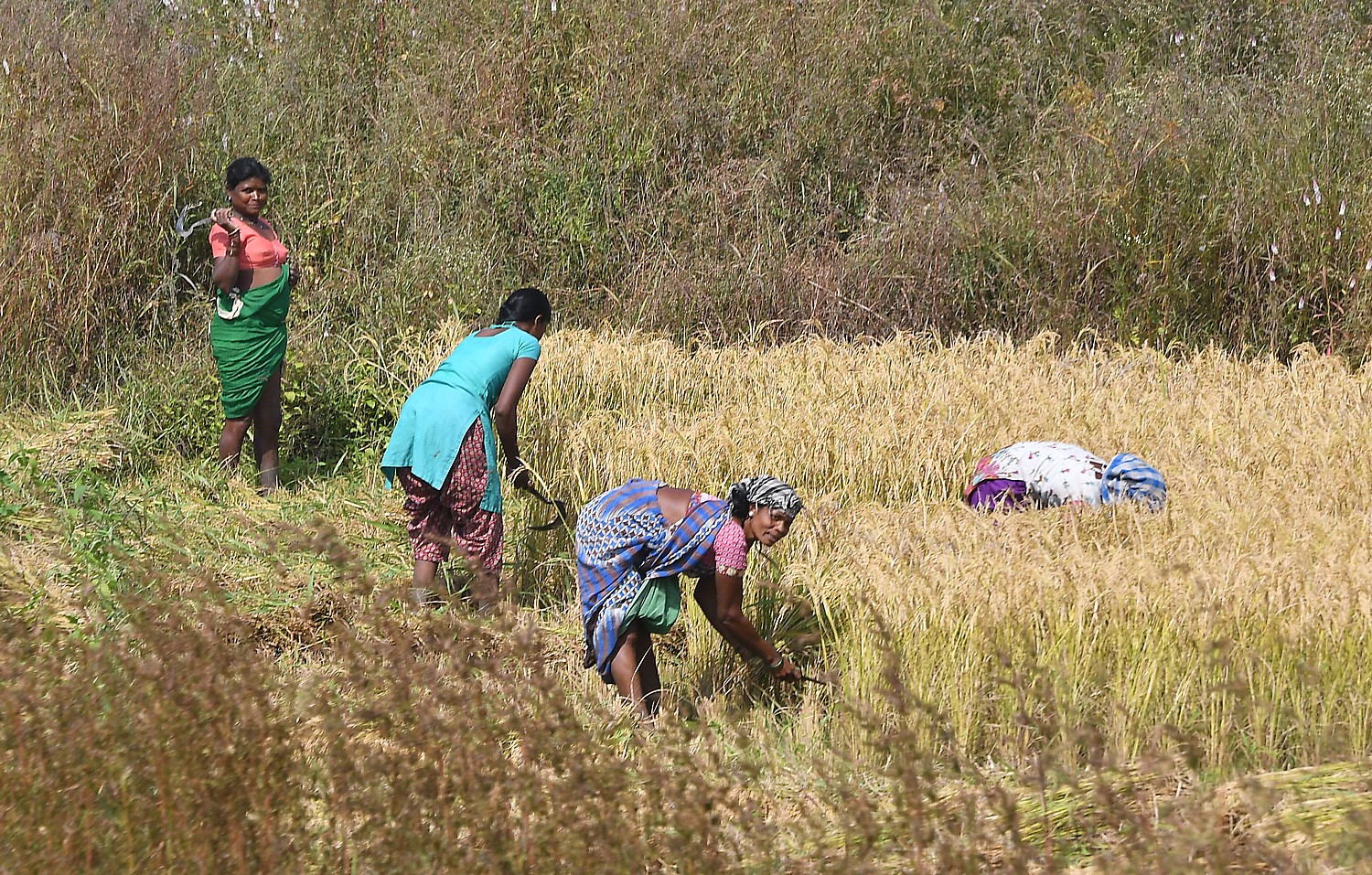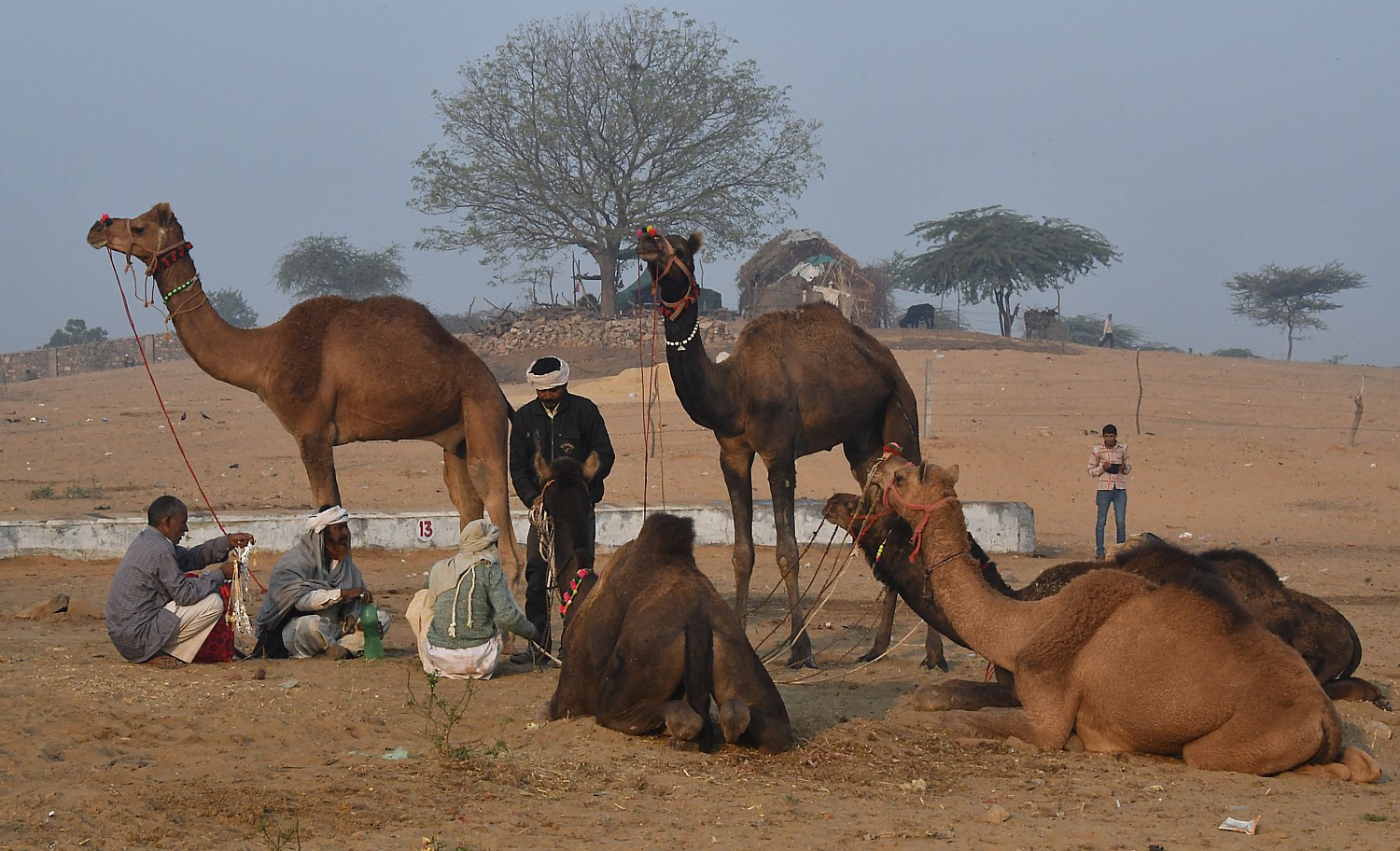
By Karen Rubin, Travel Features Syndicate, goingplacesfarandnear.com
The “Jungle Book” Wildlife Safari and Cycling Adventure chapter of our Royal Expeditions trip to India ends, but a new story begins when we leave our hotel in New Delhi, again in the darkness before dawn, to take a six-hour train journey to Pushkar in Rajasthan for the annual Pushkar Camel Fair. In many ways, this immersion into a centuries-old tradition transports us into the pages of Rudyard Kipling’s 1895 book even more tangibly than the game drives into the jungles of Mowgli and Shere Khan. See:‘Jungle Book’ Cycling Adventure Into Tiger Territory of India and ‘Jungle Book’ Cycling Adventure Through Local Villages of India’s Kanha National Park and continued with Pench National Park, India, is the Real Locale for Rudyard Kipling’s ‘Jungle Book’. Was Mowgli Real Too? and Tiger, Tiger! On Safari in India’s Kanha National Park
The Pushkar Horse and Camel Fair and Festival of Brahma takes place over a 10-day period in October/November every year, timed to take place during one of Rajasthan’s holiest festivals; the exact date varies on the western calendar but always falls during the full moon of the Indian lunar calendar month of Kartik. Pushkar is the only place in the world where Lord Brahma, the Hindu God of Creation, one of the Holy Trinity, is worshipped. A place of pilgrimage, the camel and horse fair developed out of this massive annual gathering.
The fair is a kaleidoscope of color, a swirl of motion, a cacophony of sound, unexpected up-close encounters (as with a camel), the crush of crowds.
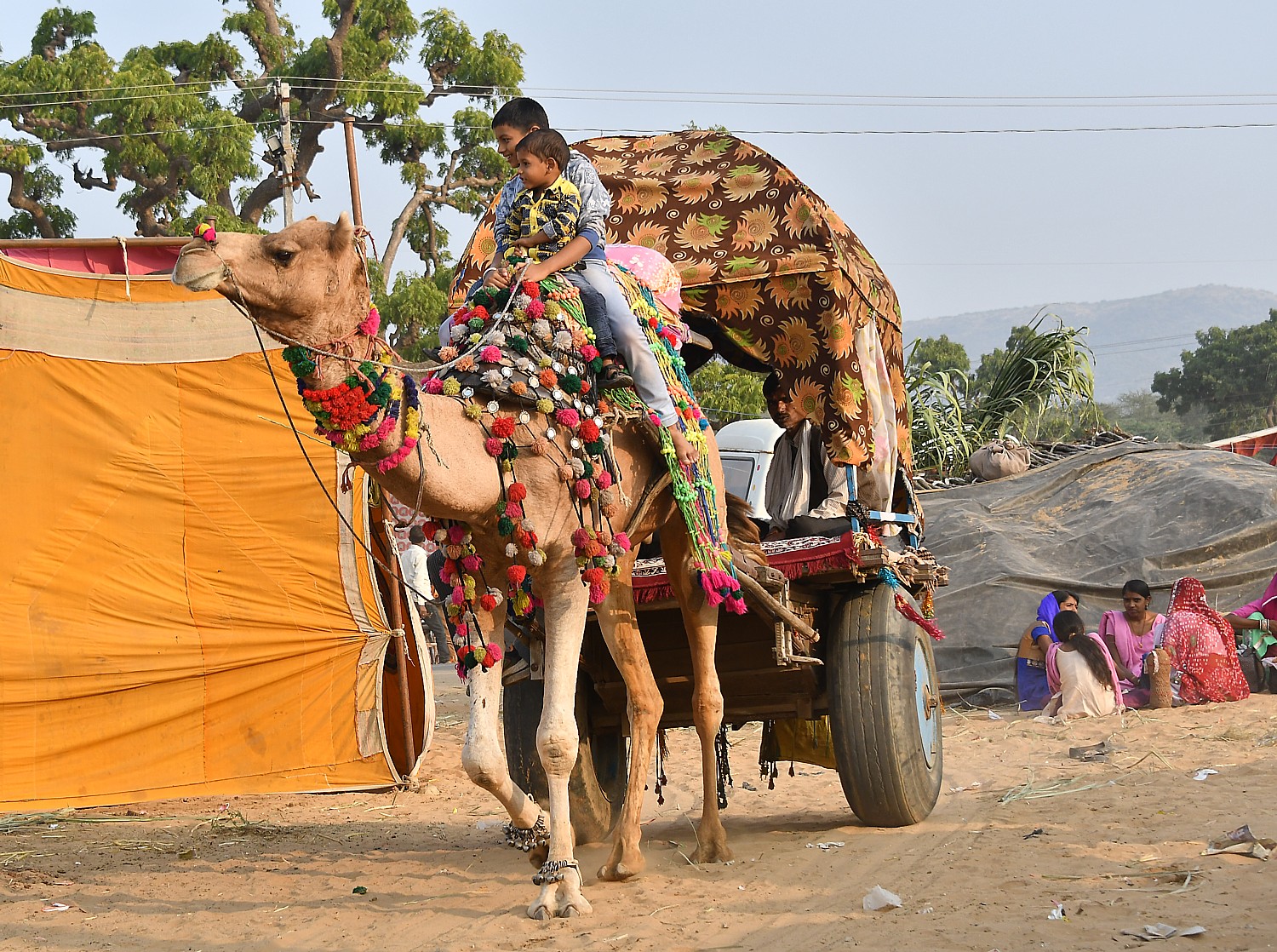
One of the greatest spectacles anywhere, in my mind the Pushkar Camel Fair is a combination of state fair, carnival and pilgrimage with a smidgeon of circus thrown in. There are snake charmers, musicians, dancing horses, magic show, ferris wheels. You can buy anything and everything – household items, decorative reins for camels and horses; street vendors selling drinks made from sugar cane, merchants selling every manner of goods from stalls and from blankets sprawled out on the road.
Traveling by Train
Our trip to the Pushkar Camel Fair starts with a fantastic six-hour train journey from New Delhi, enhancing the movie-quality of the experience.
We speed through the streets from the Sheraton Hotel, dark and amazingly vacant at 5 am compared to the chaotic snarl of traffic we navigated through when we arrived the evening before from Kanha National Park, flying from Jabalpur to New Delhi.
We pull in across from the train station and out of nowhere, fellows appear who will porter our luggage (on their heads) to the train. We follow briskly after – going through the airport-style security that we have come to expect at every hotel – and are immediately grateful for their help when we realize how we have to climb up stairs to a bridge that takes us to our track. We have time to wait – there are hundreds of people who have basically camped out on the platforms.
Our train departs just after 6 am. A porter comes through our first class car with newspapers, then tea and coffee, and then breakfast (the omelet was very good). Our Royal Expeditions guide creates a WiFi hotspot for us.
Our guide who will take us around the fair, Thurka Durga Singh, comes aboard and begins orienting us to what we will see at the fair. He is a regal looking gentleman, descended from the Warrior Class, who carries himself with grace and dignity. His voice is sonorous, and I soon discover, he is very much a poet and a storyteller, steeped in India’s traditions and culture.
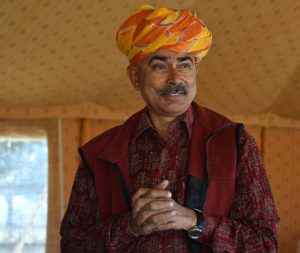
Indeed, as he would describe himself, Durga “is a keen observer of history, culture, religion, current affairs, and is a bank of knowledge so vast that he has a point of view on anything under the sun. He is what one could call a modern traditionalist, actively seeking the use of modern technology and methods to support the principles of traditional living. The inquisitive can have endless conversations with him on a number of his projects like rain – water harvesting, biogas plant, solar heating and, even, healthy cooking.” It only takes a simple question for him to launch into an entrancing narration.
“Before trains, buses, cars, all citizens traveled by animals – camel, horse. From the 11th to the15th day of the waning moon, pilgrims would come by the thousands on horses and camels from near Delhi to have a holy day. A fair developed. If you come during the first eight to 10 days of the Pushkar Camel Fair, you see more animals; in the last three days, there are more pilgrims. (Indeed, Dugar had just come from guiding a horse-riding safari to the fair.)
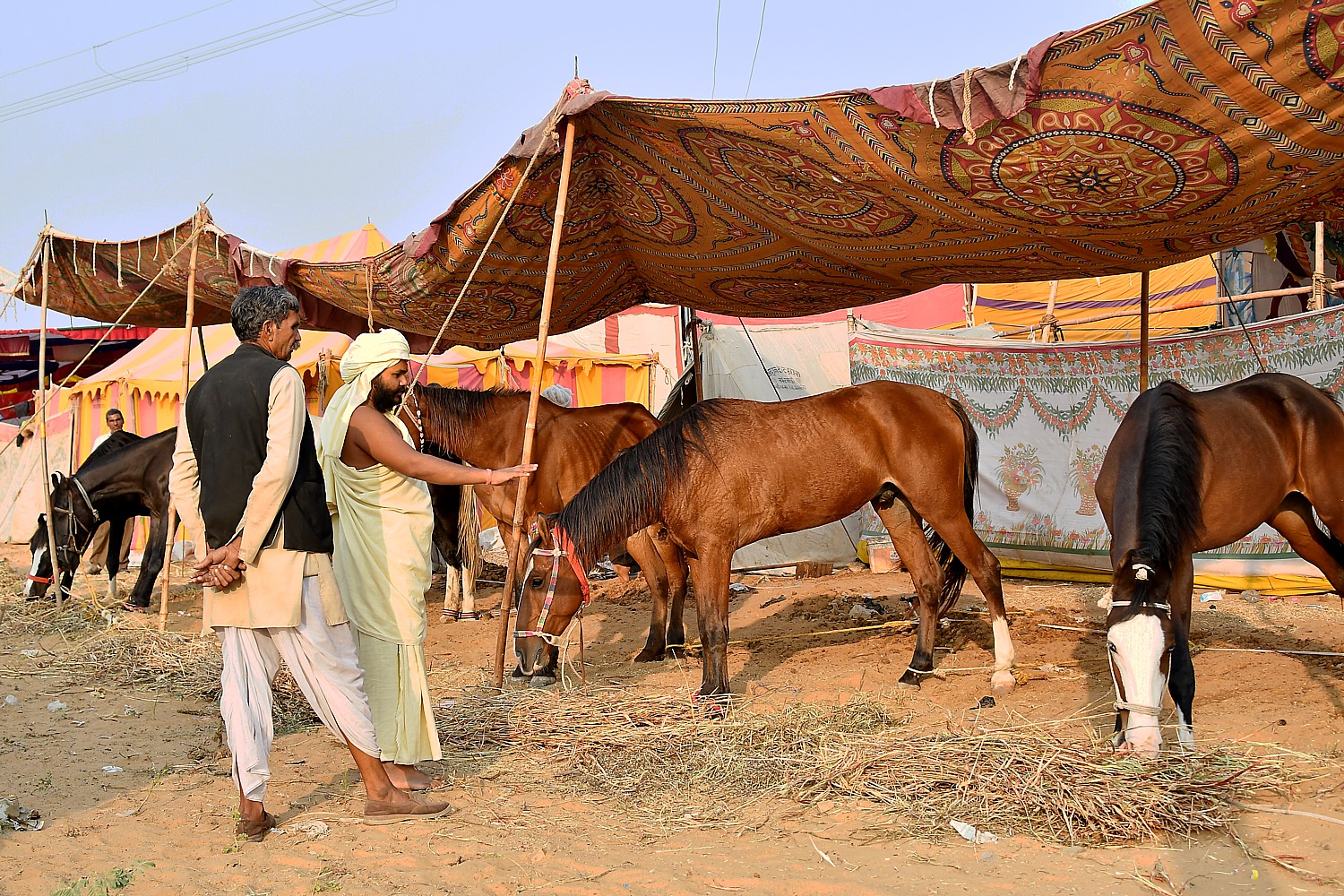
Rural farmers still use camels and horses as work animals and the Pushkar fair is one of the biggest camel, horse and live-stock fairs possibly anywhere, attracting buyers and sellers from all over the country, as well as visitors from around the world. At the peak of the fair, there might be 11,000 camels and 400,000 people coming from far and wide, dressed in their traditional and regional clothes. For days before the fair and after, you can see herders driving their camels and horses along the highway.
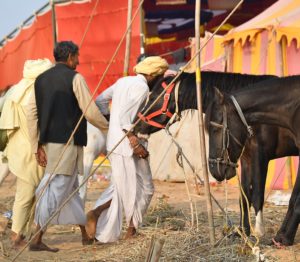
”At the fair, everything is everybody’s business. Our sense of privacy is different. Eavesdropping is a custom of the fair. People standing around give their unsolicited opinion – ‘Good horse’.” (We actually find ourselves doing this exact thing). “Now the deal is getting serious. Now the seller and the buyer don’t want others giving opinion. They clasp hands to clinch deal. Now bystanders have even more curiosity. ‘What is it your business?’ ‘I just wanted to know.’”
An ancient tradition is that when the horse is sold, it is never given with reins “because that would declare he would never have that horse again. So the buyer puts his own reins on [you can see stands that sell decorative reins.] Then the seller has money and gives a little money back, to get the horse extra food, a parting gift to the horse.
“In the western mind, business is business, there is no sentiment [recall the expression: It’s business. Not personal.]. In the Eastern mind, it is etiquette to offer tea. A Westerner would feel obligated to buy, but not an Easterner.
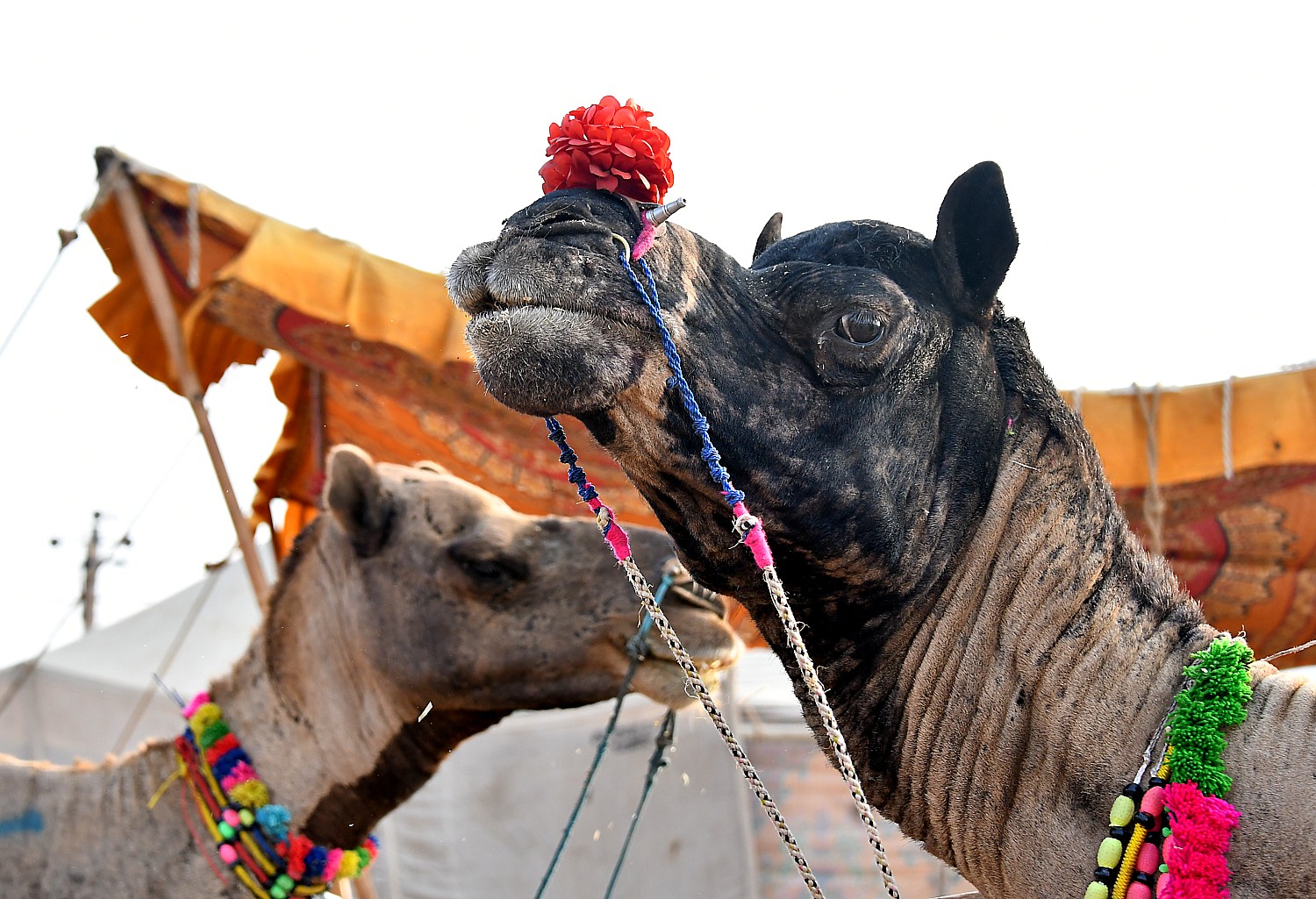
He gives us a tutorial on the different types of camels and how they are still used as work animals and why the reputation of camels as being mean and spitting isn’t really fair. One kind “can go sunrise to sunset, 60 km and has more stamina than horse. It can go without water for weeks. Camels live 26 years; 4-16 year olds work, 16-24 year olds still work but not as hard. Five minutes before it drops dead, it still doesn’t refuse work, then it drops dead.”
I ask how much a camel costs: a young camel, 2 ½ years old (they start training and work at three years old) might cost 14,000-15,000 Rupees ($205-$220); a grown, trained camel might cost 55,000-100,000 rupees ($735-$1500).
“The camel is God’s blessing to us. It browses, eats species that others don’t, like the thorny bush. He doesn’t compete for food, but he is plow, car, tractor.”
But things are changing, he says. Alas, “Young people don’t want to be stuck with an animal. They prefer a tractor…. It’s likely the Pushkar Camel Fair will disappear in 10 years.”
In India’s cash economy (they don’t use credit cards or checks), there may be 15 million rupees in cash at the fair, in bags, clothes. “There are no locks, no safes.” So men wear a vest that has a hidden pocket and put a shirt over that. “A man may have 1 million rupees and no one knows. He can’t be pick-pocketed.”
The state must collects its tax, but since there are no written records of transactions, the tax department charges a flat rate when people enter the fair.
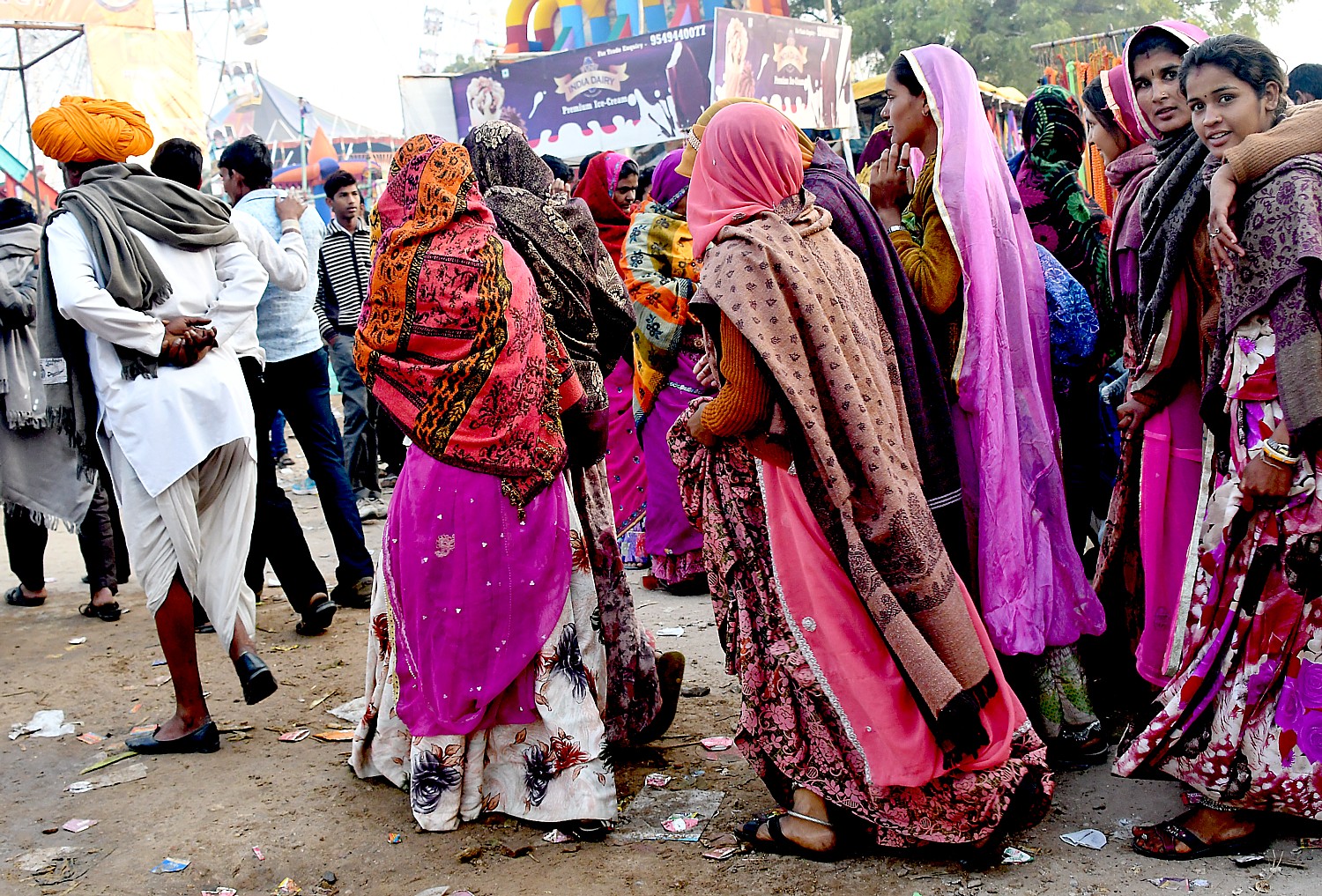
This year, is unusual, he says. We are there just as the Modi government without warning canceled the 500 and 1000 rupee bills in circulation that are the basis for an economy that still runs on cash.
“The Fair has gone into a difficult time. There are many unsold animals, owners sitting desolate. They spent money to buy the animals but have no money to bring them back. Many will leave the animals behind.”
We should also look out for the camel’s haircut. “They decorate their camel like fellows decorate their motorcycles. You wine and dine the barber – it can cost 2000-3000 rupees. The Barber used to make lovely design – a lotus flower – but the Barber has gotten quite old, he is about to go to heaven. He made peacock design; an Islamic barber makes a geometric pattern. Now you see a Sikh shearer from Punjab who works fast.”
Farmers used to collect the camel wool to make rugs, sacks; “Now nobody collects.” Well at least one group does, who we come upon in the market, Camel Charisma.
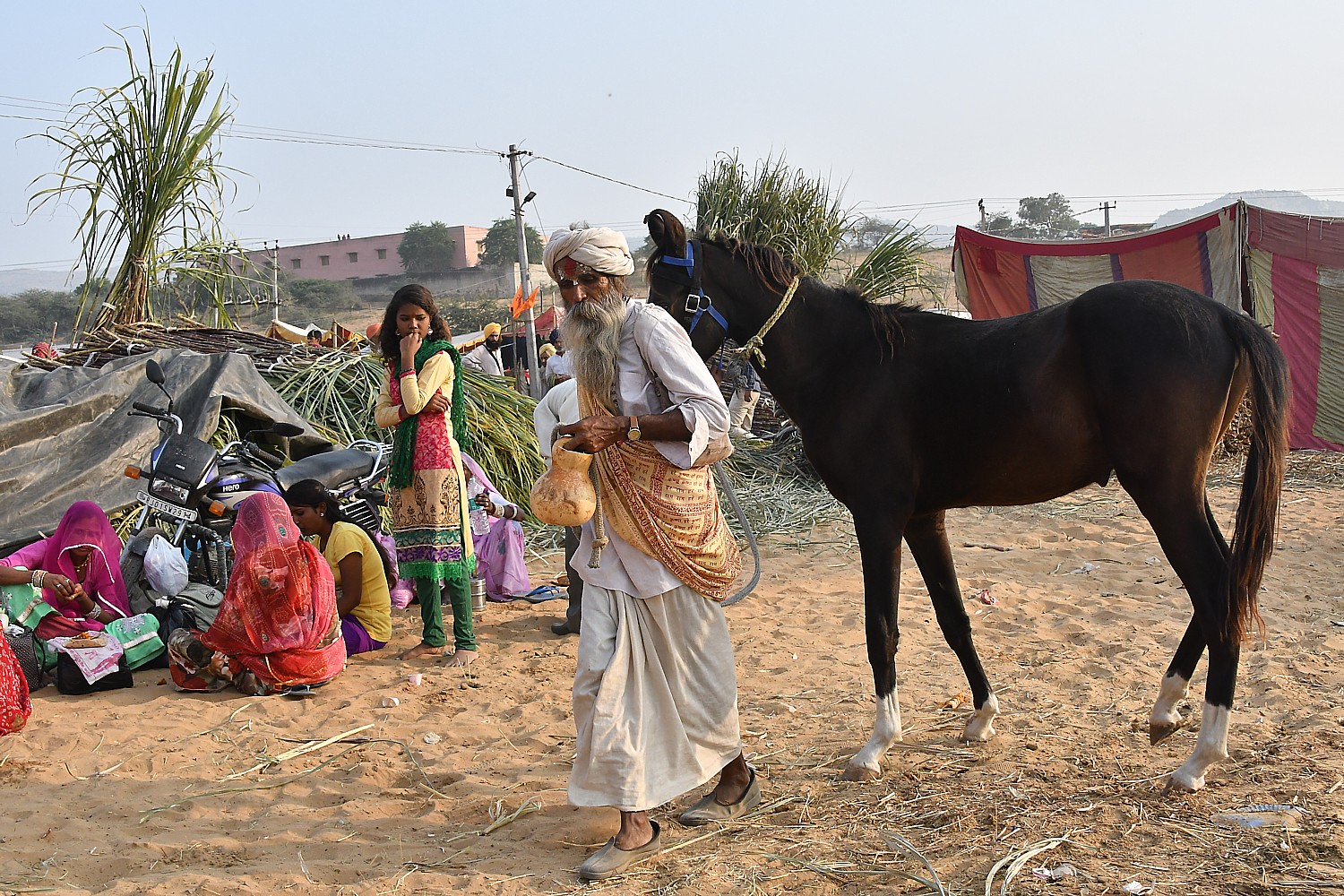
He bemoans the disappearance, one by one, of traditions (“20 years ago, women would sing folk songs. No more: girls go to school now and don’t learn folk music”).
If you come during the first eight to 10 days of the Pushkar camel fair, you see more animals; in the last three days, there are more pilgrims. “Now pilgrims come in jeeps, buses – groups of pilgrims, in different dress.”
He paints pictures of what else we will see, and lo and behold, when we arrive at the fair later that afternoon, we see for ourselves exactly what he has foretold:
“When you go to cinema, you eat popcorn – well, for desert people, sugar cane is big – trucks and trucks of sugar cane come in from the neighboring state of Pradesh.” We see stalls (a little like cotton-candy machines) crushing sugar cane into a juice add lemon and ginger.

We will see the “normal” food of the Indian countryside. “Who goes to the countryside? Hunters, nomads, pilgrims and animal trader and armies. They have to cook and eat in countryside. So they will collect dried cow droppings for cooking fuel (it’s free) [but you can actually buy cow dung patties on Amazon, I’m told] to prepare balls of wheat flour, served on a plate made of leaves.
“You light up a cow dung fire. When the fire dies down, you roast bread on the embers. It’s clean because after a half-hour of cooking, the cow dung is sterilized. Stores sell this round chat-patti fried wheat bread. It’s street food. The village pilgrims relish this food.”
The camel fair also involves a sprawling market (like a flea market), with all manner of goods for sale.
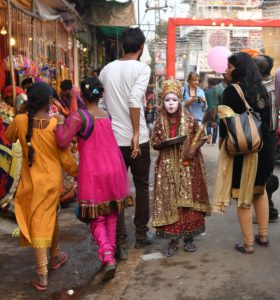
He also alerts us that we can photograph regular people –they don’t take money – but there are also “professional” photo subjects – they dress like in various costumes and you are expected to pay 100-200 rupees to take a picture (kind of like the naked cowboy in Times Square).
He warns us that “skunks” spoil the visit for Indians and foreigners. They solicit money – “Mafia like” =saying they want to take you to the lake. Tell them ‘We have been to the lake.”
He says he will take us to the roof of a restaurant to see the lake and watch the rituals.
The beauty of the fair is its randomness, a kaleidoscope of colors, a swirl of activity, he says. “No guidebook will tell you this aspect.”
His narration has made the hours spent on the train fly by. Before we know it, we pull into Ajmir.
Ajmir, A Holy City
We arrive in Ajmir and once we are underway in our van for the half-hour ride to Pushkar, Durga has us join in reciting a Hindu blessing, since Ajmir is one of the holiest places for Hindus, Buddhists and Jains.
The story goes that when Sati died, Shiva cried so much and for so long, that his tears created two holy ponds – one at Pushkara in Ajmer in India and the other at Ketaksha, which means “raining eyes” in Sanskrit.
One of India’s first cities, Ajmir was the Chahamana capital ruling all India until the defeat of Prithviraja lll in 1192 when the city came under Muslim rule. And when India was under British rule and divided into 526 Maharajah states, the Viceroy, the direct link to the British Crown, was based in Ajmir.
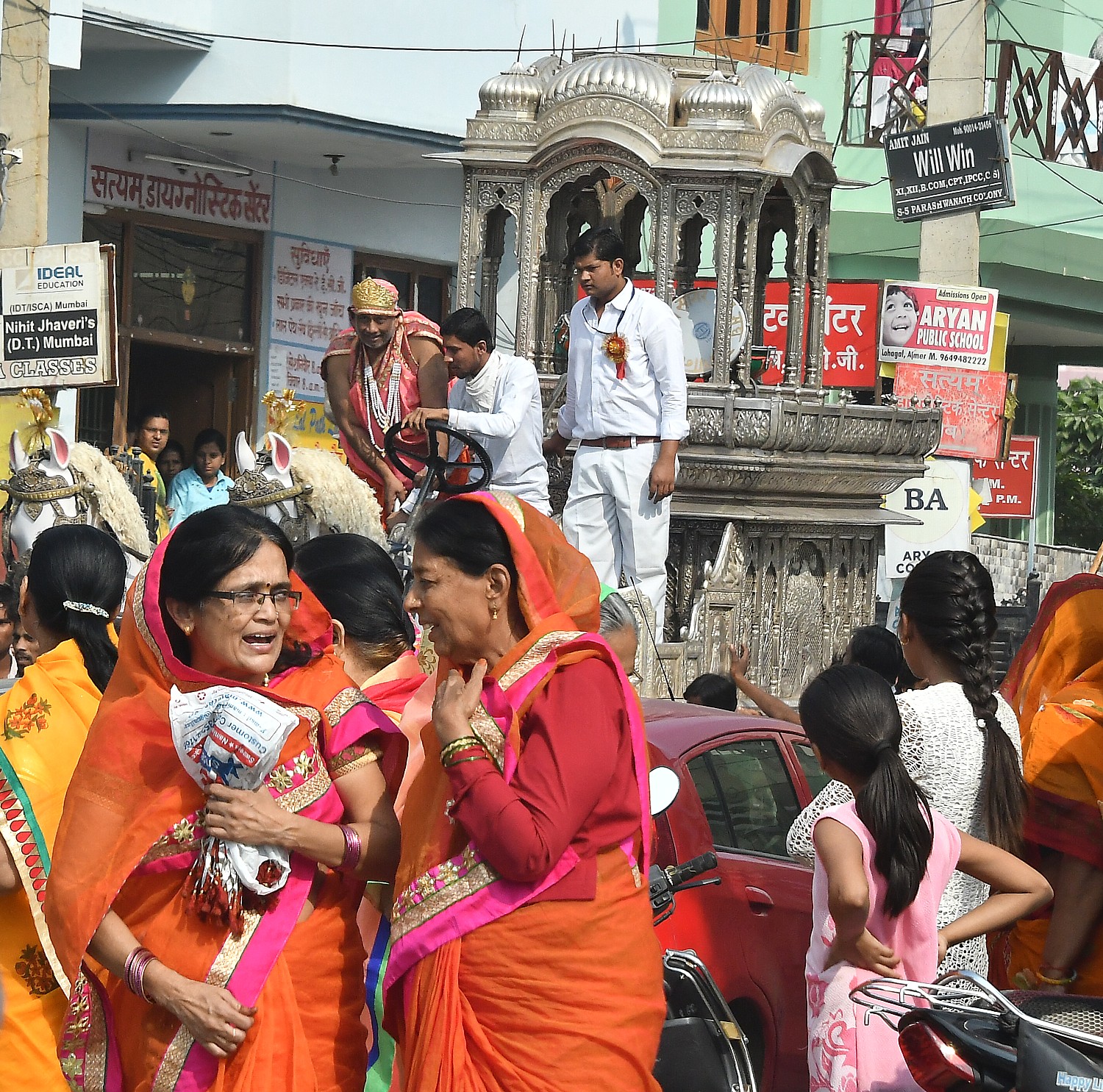
Ajmir also has one of the most important Sufi shrines, “next to Mecca and Medina, one of the holiest for Muslims.”
Moinuddin Chishti, an important Iman practicing the Sufi form of Islam, came to Ajmir from Iran, developing a large following, and gaining the respect of the residents of the city. Chishti promoted understanding between Muslims and non-Muslims.
Sufism is a Muslim movement which arose in the 8th-9th centuries, whose followers seek to find divine truth and love through direct encounters with God. Sufis, Durga explains do not believe that nonbelievers are infidels (like the more extreme Wahabis). Every individual is God’s children. Music is an important part of worship, connecting worshippers to the divine. He has as much a following among Hindus as Muslims. Many Muslims live here.”
In some ways, it seems Ajmir is like Jerusalem in that it is the confluence of these different religions.
During our brief ride, Durga explains reincarnation, predestination and freewill (no mean feat), connecting reincarnation to Darwin. “Darwin talks of physical evolution, Einstein of the soul transfiguring. There is a zero balance account when you are born – that’s free will. Now you start creating your karma; that brings you back again and again. The aim of life is to go back to the Godhead, to break the cycle of birth and rebirth.” Reincarnation, rebirth and nirvana, he says, is not that much different than Christianity’s belief in resurrection and heaven. “There are many commonalities.”
Free will and destiny are not contradictory. “Destiny is that you find a note, then free will is what you do with it. You receive your past and create your future – that is the secret of happiness. In the East, there is no place for guilt” because actions have repercussions in future life.
As for why cows are sacred, it basically comes down to a very practical reason: people depend on the cow. “The cow was revered before it became holy.” We see cows with their horns that had been painted for the Diwali Festival.

We make our way slowly through a snarl of humanity, traffic cops doing their best to organize. Because of the traffic during the fair, we are led the long way around, traveling around the lake and over Nag Pahar, the Snake Mountain, separating Pushkar from Ajmer. We don’t mind at all because we get to see more of the city and landscape.
Coming into Pushkar, we bypass the entrance to the fair – it is wall-to-wall people, since it is toward the end of the fair now mostly pilgrims as opposed to camel and horse buyers – enroute to the Royal Tents, a luxurious tented camp set up by The Royal Jodhpur Camps specifically for the fair, where we stay.

The Royal Jodhpur Camp is set up as a traditional “shikar” style camp: at a time when only royalty was allowed to hunt, these camps were set up to accommodate them. Ours consists of rows of elegant and luxurious twin bedded tents with verandahs with deck-chairs in front and attached bathrooms with running hot and cold water (even a shower), set out over an expansive sandy plain. There are electric lights, an electric heater, rugs on the ground. There is also a spacious Mughal-style dining tent and a recreation tent which serves as a lounge. It is set on expansive private grounds surrounded by rolling mustard fields in flower and rocky hills, a walk or camel ride away from the fair.
It is the ultimate in glamping. We can tie a triangular flag to a rope outside the tent to signal if we want service (room service, hot water). We can order coffee delivered in the early morning.
We feel much as the royal entourage who would come on hunting expeditions and stay in these elaborate camps. The operative word is “royal.”
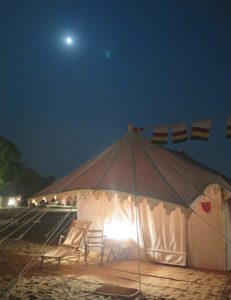
Indeed, The Royal Jodhpur Camps actually has a family connection to Royal Expeditions, the tour company that has organized our Jungle Book Wildlife Safari and Cycling Adventure and this extension to the Pushkar Camel Fair, Jaipur and Agra. Royal Expeditions was founded by a royal family of Jodhpur related to a Princess who also served in Parliament and as India’s Minister of Culture, and the Royal Jodhpur Camps is her brother’s enterprise. It makes it all the more fantastic. And like our other accommodations – the Pench Tree Lodge and the Kanha Earth Lodge during our time doing wildlife safaris in the national parks – it enhances our Camel Fair experience.
We have a superb lunch in an enormous dining tent (complete with ceiling fan), before setting out for our visit to the fair.
Day into Night at Pushkar Camel Fair
Durga has timed it so we arrive at the fair in the afternoon and will be here after dark, to get the full color and atmosphere.
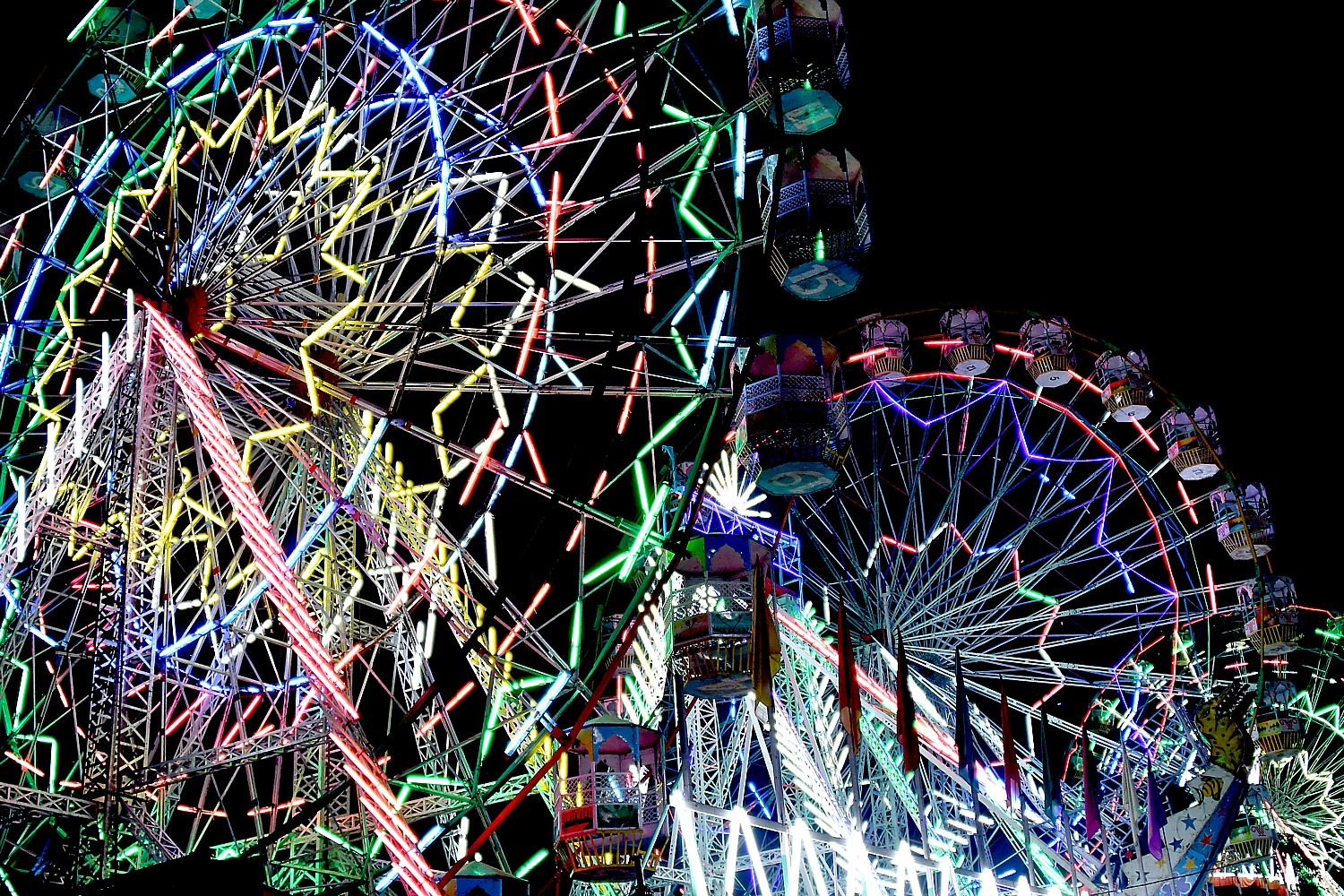
Soon we are caught up as we watch a transaction for a horse, just as Durga foretold we would during our train ride: “At the fair, everything is everybody’s business.” And just as he described, we watch a fellow eyeing a horse. And just as he described, soon we find ourselves chiming in as if it is our business, “Oh, that’s a fine-looking horse.” And just as Durga had described, moments later, the seller grabs the customer’s hand and pulls him inside the tent, where he most likely will be plied with tea so the negotiations can commence out of the gaze of prying eyes and gossipy critics.
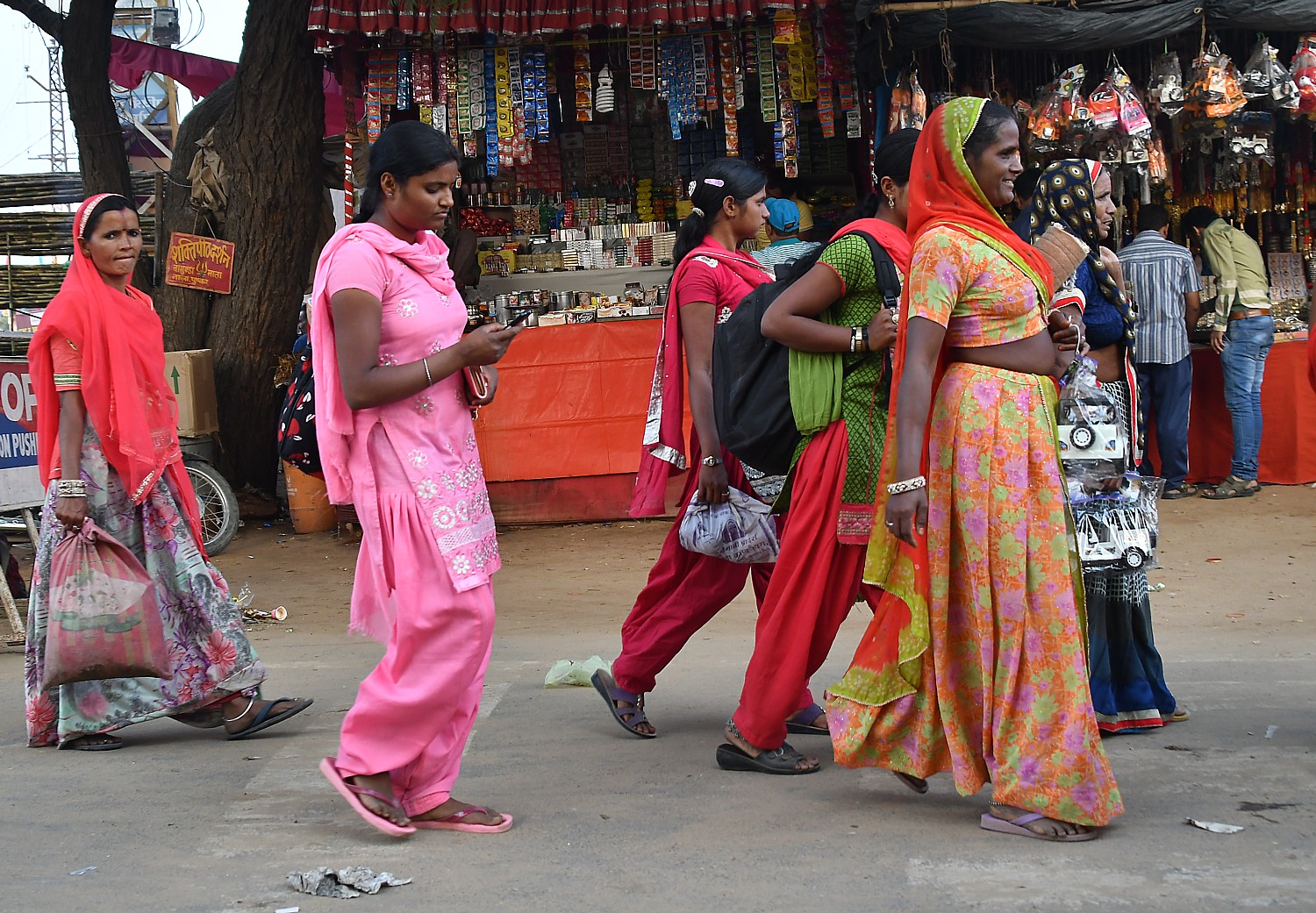
Durga leads us through a vast market with just about every item you can imagine for sale: shoes, scarves, household items; saddles and decorative reins and leashes for the camels and horses.
We see albino horses for sale, which Durga says are used for weddings. He introduces me to Bakshu, a prominent horse breeder he knows from Gudrash, and Raika, a professional camel breeder.
We pass by a tent where there is magic show on our way to the market.
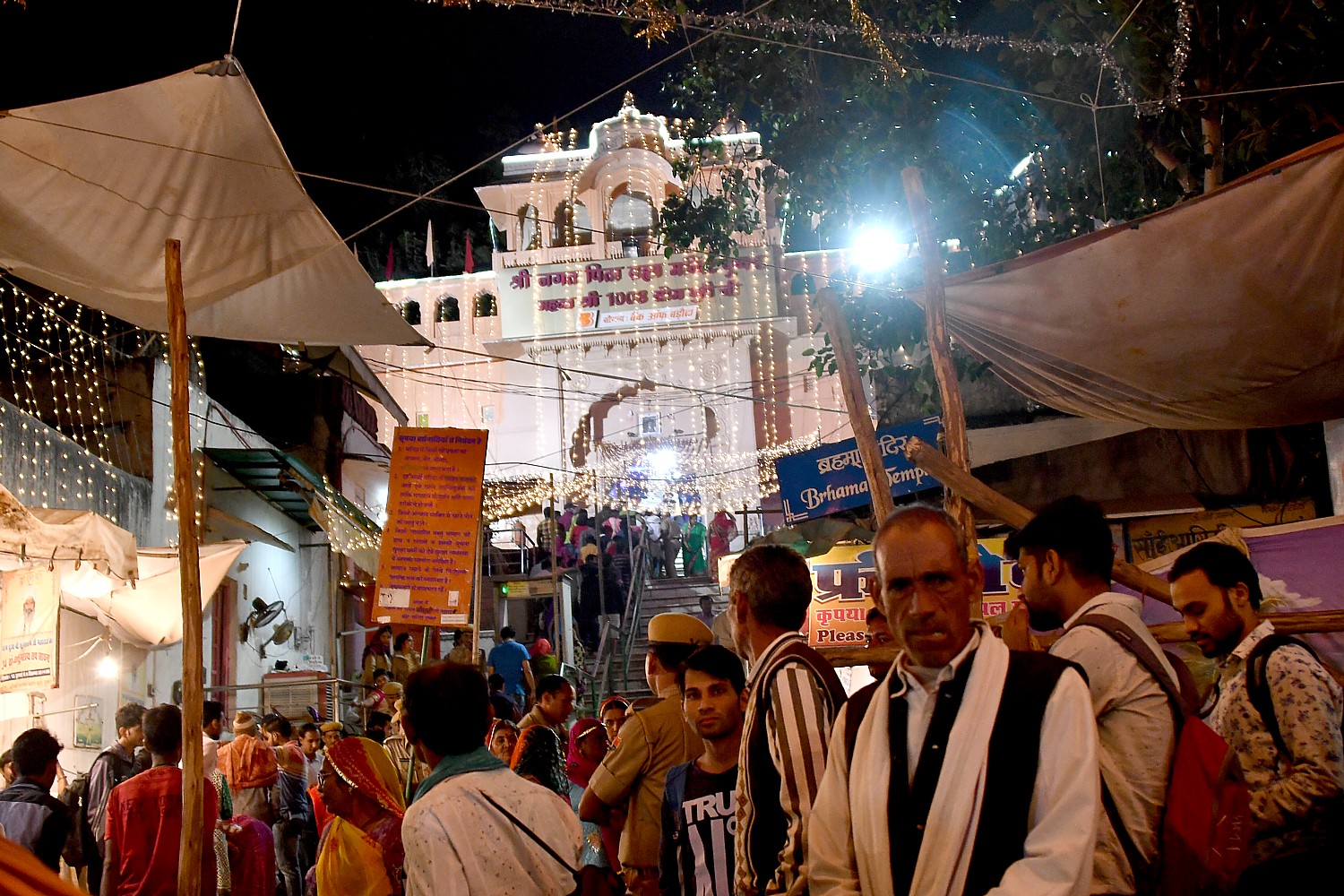
He takes us to what is probably the most distinctive shops at the fair, Camel Charisma, where you can buy paper out of camel dung; scarfs form discarded camel hair (and silk), 2500 R ($36), fresh camel milk, camel milk soap and just about anything you can imagine from camel. We taste chai made of camel milk. He takes us to his favorite textile stall (I’m still kicking myself for not buying an embroidered wool wrap for $25).
He takes us passed temples, jam-packed with worshippers, to where we can go to a rooftop to look down on the holy lake and the religious rituals underway. We watch as the sun sets, the lights come on and a super moon rises over the Pushkar Lake.

Pushkar is the only place in the world where Lord Brahma, the Hindu God of Creation, one of the Holy Trinity, is worshipped. The Brahma Temple, which officially is dated from the 14th century but is believed to be 2000 years old, is set on the lake, and during the night, lights of changing colors come on. In the distance, on a hilltop, we can make out the Savitri Temple, dedicated to Brahma’s consort, Savitri, but to visit involves an hour long trek uphill.

Around the lake are numerous bathing ghats, where thousands of pilgrims take their holy dip in the sacred waters of Lake Pushkar, as religious chanting and pealing bells resound. We get to peer down on these activities from our perch on the roof, watching people gather around open fires.
We make our way back through the market and the carnival, now lighted up and festive, with five giant ferris wheels looming over the fair. We pass a crowd watching a dancing horse.
When we return to the tented camp, where we have a marvelous dinner (with Sula champagne!).

We comment on how good the papadom is – a seasoned dough made with mung bean flour fried or cooked with dry heat. “In my grandmother’s day, they used to invite women for lunch, sing, everyone came with a rolling pin, they would sing and make the papadom and put it out in the sun to dry,” Durga says.
There is a fireeater, musicians and dancers to entertain us around a bonfire.
I return to the fair the next morning by myself. Durga has arranged for the driver to pick me up at 7 am. As we pull up, I watch as a hot air balloon rises over the fair. (Hot air ballooning is a relatively new adventure activity in India and the desert state of Rajasthan is the most popular place.)
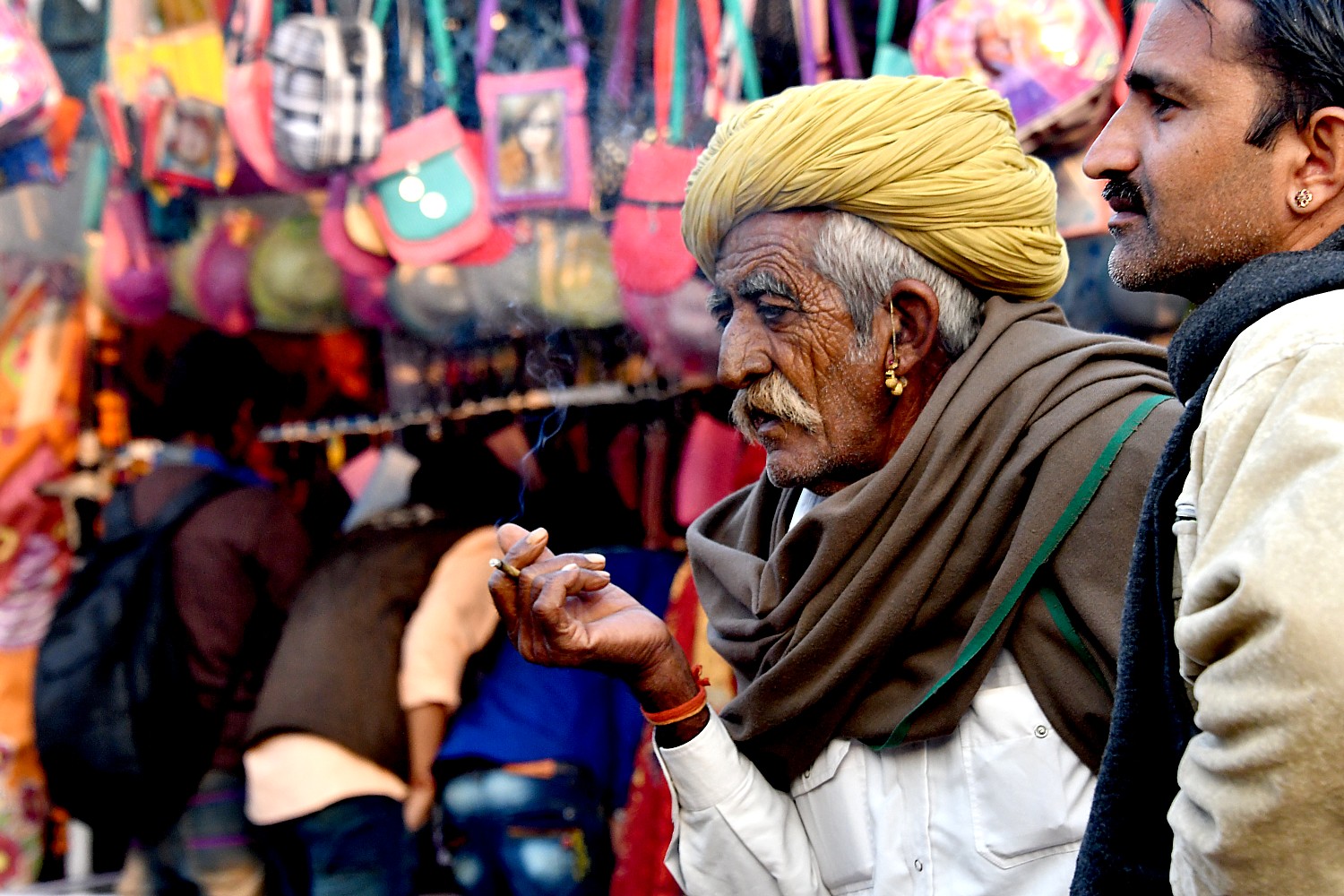
I get to the fair and just wander around – I am one of a scant few Westerners at this point. It is amazing to me how busy it is even this early in the morning. There are only a few camels left for sale and I watch what looks like the end of a transaction.
Leaving the fair, I see pilgrims arriving in open-back trucks, and in trucks that have been outfitted with bunkbeds.
Durga has told us that it can take 10 days to travel from Agra with the camels, and that we will see people in their camel carts traveling along the highway, as we drive to our next destination, Jaipur. And we do!
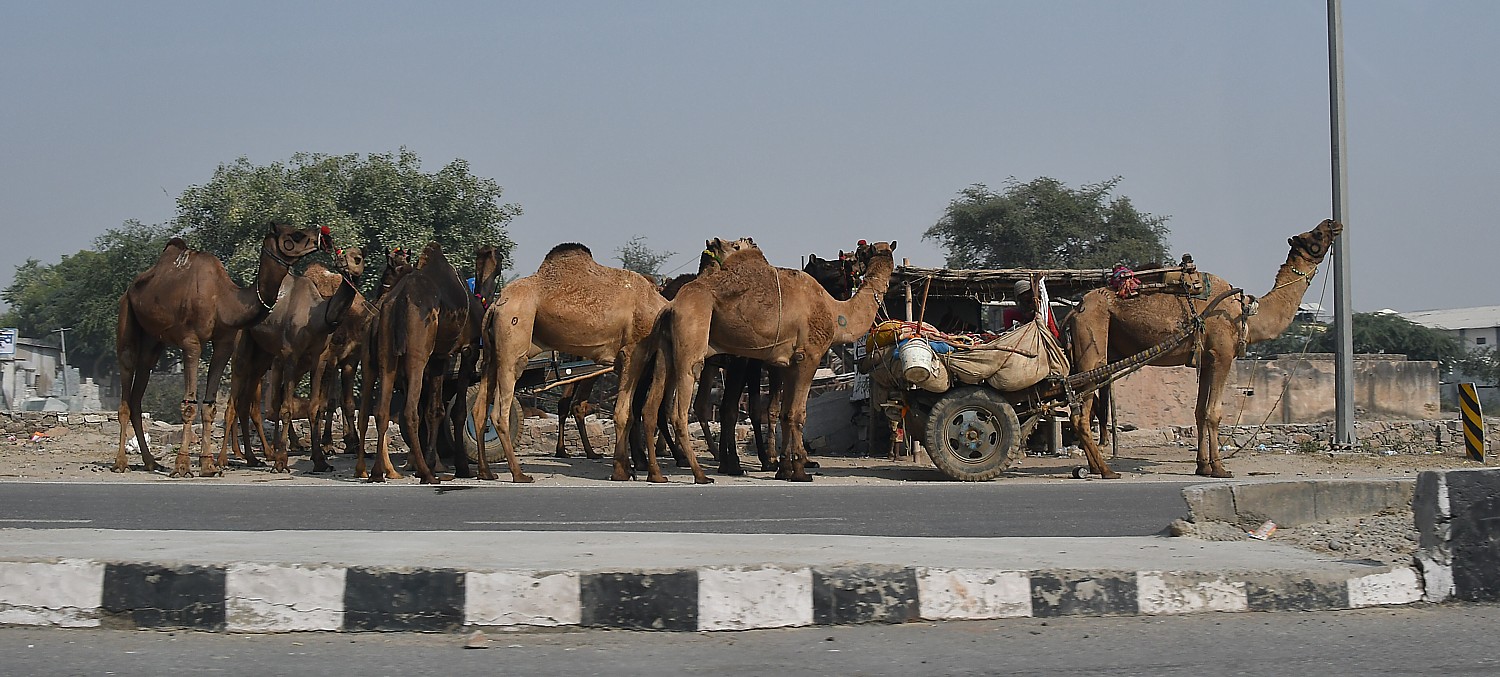
In Jaipur, we learn more about this regal gentleman and his family, when we visit his boutique guesthouse, Dera Mandawa – his family’s century-old estate which, back in the day, accommodated dignitaries when they visited the Maharajah. The family lost their property and position when India nationalized such estates in the 1949, and families like his were forced to turn their estates and palaces into commercial enterprises or see them torn down. Instead of the path of a warrior as his ancestors would have taken, Durga has been involved in tourism for 35 years. (www.deramandawa.com)
For more information, contact Royal Expeditions Pvt. Ltd. www.royalexpeditions.com, [email protected], or Royal Expeditions’ North American representative: [email protected], 720-328-8595.
See also:
‘Jungle Book’ Cycling Adventure Into Tiger Territory of India
‘Jungle Book’ Cycling Adventure Through Local Villages of India’s Kanha National Park
Tiger, Tiger! On Safari in India’s Kanha National Park
____________________
© 2017 Travel Features Syndicate, a division of Workstyles, Inc. All rights reserved. Visit goingplacesfarandnear.com and travelwritersmagazine.com/TravelFeaturesSyndicate/. Blogging at goingplacesnearandfar.wordpress.com and moralcompasstravel.info. Send comments or questions to [email protected]. Tweet @TravelFeatures. ‘Like’ us at facebook.com/NewsPhotoFeatures


